Téléchargements
Exécutable de l'éditeur de niveaux - exactement le même que la partie 40 (Windows 32bits)
Exécutable du jeu (Windows 32bits)
Avant d'essayer de compiler le code, allez dans l'onglet "Projets" dans le menu de gauche, séléctionnez l'onglet "Run" pour votre kit,
et mettez dans "Working directory" le chemin de "editor\data" pour l'éditeur ou "game\data" pour le jeu.
Dégâts et mort
Maintenant on va vraiment réduire leur vie et voir comment ils meurent.
D'abord il faut qu'on termine la fonction hitChampion().
void CCharacter::hitChampion(int num, int damages)
{
// déjà mort ou vide ?
if (portrait == -1 || isDead() == true)
return;
displayedDamages = damages;
damagesTimer.set(90, false);
stats[eStatHealth].value -= damages;
static CVec2 championPos[4][4] =
{
{{0, 0}, {1, 0}, {0, 1}, {1, 1}}, // up
{{0, 1}, {0, 0}, {1, 1}, {1, 0}}, // left
{{1, 1}, {0, 1}, {1, 0}, {0, 0}}, // down
{{1, 0}, {1, 1}, {0, 0}, {0, 1}} // right
};
// mort ?
if (stats[eStatHealth].value <= 0)
{
stats[eStatHealth].value = 0;
// jette tous les objet sur le sol
CVec2 stackPos = player.pos * 2 + championPos[player.dir][num];
CObjectStack* stack = map.addObjectsStack(stackPos, eWallSideMax);
for (int i = 0; i < eBodyPartCount; ++i)
{
CObject& obj = bodyObjects[i];
if (obj.getType() != 0)
{
stack->addObject(obj);
obj.setType(0);
}
}
// jette les os du champion
CObject bones;
bones.setType(OBJECT_TYPE_BONES);
bones.setIntParam("Champion", num);
stack->addObject(bones);
}
}
Quand il est mort, on fait tomber tous ses objets sur le sol.
La table championPos nous donne les positions où faire tomber ces objets en fonction de la direction du joueur.
Ca ressemble à ça:
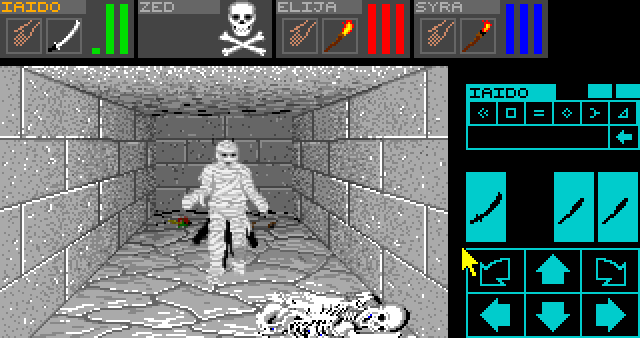
Vous pouvez voir que j'ai ajouté un paramètre "Champion" à l'objet os.
<!-- OS DE # -->
<item name="ITEM149">
[...]
<param type="int">Champion</param>
</item>
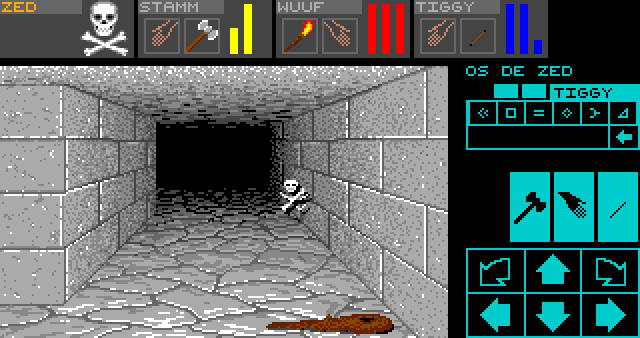
On utilise la fonction qu'on a écrite pour les messages en bas de l'écran pour insérer ce nom dans le texte.
void CInterface::drawObjectName(QImage* image)
{
int type = mouse.mObjectInHand.getType();
if (type != 0)
{
std::string name;
if (type == OBJECT_TYPE_BONES)
name = setChampionNameInString(mouse.mObjectInHand.getIntParam("Champion"), "ITEM149");
else
name = objects.mObjectInfos[type].name;
drawText(image, CVec2(233, 33), eFontStandard, name.c_str(), MAIN_INTERFACE_COLOR);
}
}
Se cogner contre les murs
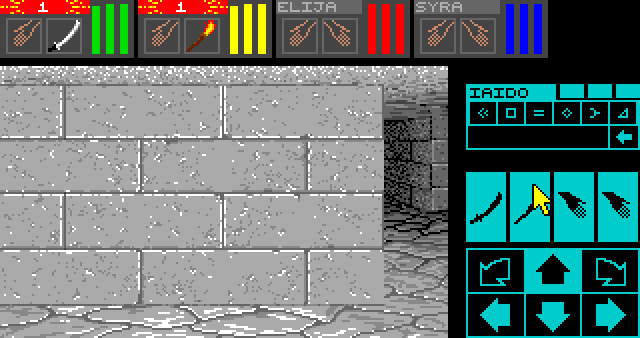
Quand l'équipe se cogne dans un mur, les 2 champions dans la rangée de devant par rapport au mur reçoivent des
dégâts.
La valeur de ces dégâts dans le jeu d'origine était calculée avec une formule étrange basée sur les stats du
champion, mais je l'ai remplacée par un simple random entre 1 et 2.
void CPlayer::moveIfPossible(EWallSide side)
{
[...]
if (canMove == true)
{
[...]
}
else
{
if (game.characters[0].portrait != -1)
{
static const int championsHit[eWallSideMax][2] =
{
{0, 1}, // eWallSideUp
{2, 3}, // eWallSideDown
{0, 2}, // eWallSideLeft
{1, 3} // eWallSideRight
};
for (int i = 0; i < 2; ++i)
{
int champNum = championsHit[invWallSide(side)][i];
game.characters[champNum].hitChampion(champNum, (RANDOM(4) == 0 ? 2 : 1));
}
sound->play(newPos, "sound/Party_Damaged.wav");
}
}
}
cas où les 2 joueurs de devant sont morts.
Mais on devra réécrire ces fonctions quand on ajoutera le placement des personnage au sein de l'équipe.
Tomber dans un trou
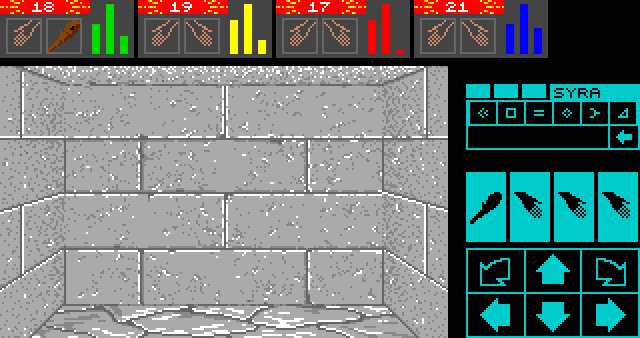
Quand l'équipe tombe dans un trou, chaque champion reçoit des dégâts.
C'est une valeur aléatoire autour de 20. Mais ça changera quand on ajoutera les blessures aux personnages.
void CPlayer::fall()
{
[...]
hitAllChampions(20);
}
//-----------------------------------------------------------------------------------------
void CPlayer::hitAllChampions(int damages)
{
int rnd = damages / 8 + 1;
sound->play(pos, "sound/Party_Damaged.wav");
for (int i = 0; i < 4; ++i)
{
int dmg = damages - rnd + RANDOM(rnd * 2);
dmg = MAX(1, dmg);
game.characters[i].hitChampion(i, dmg);
}
}
L'autel Vi
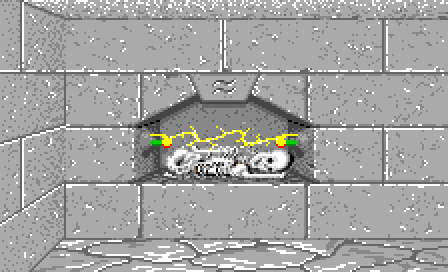
Quand vous placez les os d'un champion à l'intérieur d'un autel Vi, le processus de résurrection commence.
On va stocker la position du mur et son coté, et démarrer un timer.
void CGame::update(SMouseArea* clickedArea)
{
[...]
else if (clickedArea->type == eMouseAreaG_DropObject)
{
// récupère la position et le coté
[...]
// jette l'objet
CObjectStack* stack = map.addObjectsStack(pos, side);
stack->addObject(mouse.mObjectInHand);
// test si on ressuscite un champion
if (mouse.mObjectInHand.getType() == OBJECT_TYPE_BONES &&
side != eWallSideMax)
{
CWall& wall = map.getTile(pos)->mWalls[side];
if (wall.getType() == eWallAlcove &&
wall.getEnumParam("Type") == 2)
{
// ressuscite
sound->play(pos, "sound/Spell.wav");
walls.resurrectWallPos = pos;
walls.resurrectWallSide = side;
walls.resurrectTimer.set(120, true);
}
}
Le graphisme de l'éclair vient d'un missile "éclair", mais on parlera des missiles dans une autre partie.
L'animation consiste à retourner cette image d'éclair toutes les 1/2 secondes, et elle est affichée comme un décor
de mur.
CWalls::COrnateData alcoveLightning =
{
"",
"gfx/3DView/missiles/Lightning_side.png",
"",
{82, 95},
{0, 0}
};
//---------------------------------------------------------------------------------------------
CRect CWalls::drawOrnate(QImage* image, CVec2 tablePos, EWallSide side, int ornate, int textLines)
{
if (ornate != 0)
{
int tableSide = walls.getTableSide(side, false);
if (gWallsInfos[tablePos.y][tablePos.x][tableSide].size.x != 0)
{
COrnateData* ornateData = NULL;
if (ornate == ORNATE_ALCOVE_LIGHTNING)
ornateData = &alcoveLightning;
else
ornateData = &walls.ornatesDatas[ornate];
[...]
// dessine les décors à l'écran.
bool flipX = false;
bool flipY = false;
if (ornate == ORNATE_ALCOVE_LIGHTNING)
{
int image = walls.resurrectTimer.get() / 30;
flipX = image & 1;
flipY = (image >> 1) & 1;
}
graph2D.drawImage(image, ornatePos, tempImage, 0, flipX, QRect(0, 33, MAINVIEW_WIDTH, MAINVIEW_HEIGHT), flipY);
Explosion

Quand l'animation d'éclair se termine, une explosion apparaît pendant une courte durée.
J'ai créé un nouveau fichier "explosions.cpp" pour gérer ça parce que les explosions et les nuages seront très
utilisés pour les sorts.
Une fonction add() est appelée pour créer une nouvelle explosion et l'ajouter à une liste.
Les paramètres de cette fonction sont la position dans la map, le type d'explosion, et sa durée.
void CExplosions::add(EExplosions type, CVec2 mapPos, int duration)
{
SExplosion explo;
explo.type = type;
explo.mapPos = mapPos;
explo.timer.set(duration, true);
mExploList.push_back(explo);
if (type == eExplo_Resurrect)
sound->play(mapPos, "sound/Explosion.wav");
}
terminées.
void CExplosions::update()
{
std::vector<SExplosion>::iterator it = mExploList.begin();
while(it != mExploList.end())
{
if (it->timer.update() == true)
it = mExploList.erase(it);
else
it++;
}
}
void CExplosions::draw(QImage* image, CVec2 mapPos, CVec2 tablePos)
{
for (size_t i = 0; i < mExploList.size(); ++i)
{
SExplosion& explo = mExploList[i];
if (explo.mapPos == mapPos)
{
QImage exploGfx;
CVec2 pos;
float scale = 1.0;
if (explo.type == eExplo_Resurrect)
{
exploGfx = fileCache.getImage("gfx/3DView/explosions/Fireball.png");
pos = CVec2(57, 66);
scale = 110.0 / 145.0;
}
const SWallInfos* tabData = &gWallsInfos[tablePos.y][tablePos.x][eWallSideUp];
if (tabData->size.x != 0)
{
const SWallInfos* refWall = NULL;
refWall = &gWallsInfos[3][2][eWallSideUp];
// calcule la position et la taille et dessine l'explosion dans une image temporaire
scale *= (float)tabData->size.y / 111.0f;
QSize scaledSize = exploGfx.size() * scale;
pos = pos - refWall->pos;
pos.x = pos.x * tabData->size.x / refWall->size.x;
pos.y = pos.y * tabData->size.y / refWall->size.y;
pos += tabData->pos;
QImage tempImage(scaledSize, QImage::Format_ARGB32);
tempImage.fill(TRANSPARENT);
graph2D.drawImageScaled(&tempImage, CVec2(), exploGfx, scale);
// assombrit l'explosion en fonction de sa distance
static const float shadowLevels[] = {0.0f, 0.2f, 0.4f};
float shadow = shadowLevels[WALL_TABLE_HEIGHT - 1 - tablePos.y];
graph2D.darken(&tempImage, shadow);
// dessine l'explosion à l'écran.
graph2D.drawImage(image, pos, tempImage, 0, false, QRect(0, 33, MAINVIEW_WIDTH, MAINVIEW_HEIGHT));
}
}
}
}
void CWalls::update()
{
// animation de l'autel vi
if (resurrectTimer.update() == true)
{
// retrouve le numéro du champion
CObjectStack* stack = map.findObjectsStack(resurrectWallPos, resurrectWallSide);
int last = stack->getSize() - 1;
CObject& bones = stack->getObject(last);
int champNum = bones.getIntParam("Champion");
// efface l'objet
stack->removeObject(last);
resurrectWallSide = eWallSideMax;
// ressuscite le champion
CCharacter::SStat& health = game.characters[champNum].stats[CCharacter::eStatHealth];
health.value = health.startValue / 2;
// lance l'explosion
explosions.add(eExplo_Resurrect, player.pos, 20);
}
}
Régénération de vie
dort.
Donc, comme pour le mana, j'ai utilisé un timer qui est initialisé avec 2 valeurs suivant qu'on dort ou pas.
#define HEALTH_REGEN_TIMER (30 * 60)
#define HEALTH_REGEN_TIMER_SLEEP 90